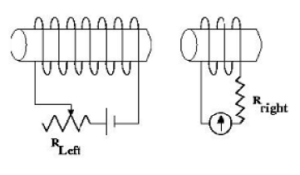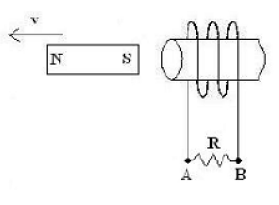Question

For the solenoids shown in the diagram (which are assumed to be close to each other), the resistance of the left-hand circuit is slowly increased. In which direction does the ammeter needle (indicating the direction of conventional current) in the right-hand circuit deflect in response to this change?
A) The needle deflects to the left.
B) The needle deflects to the right.
C) The needle oscillates back and forth.
D) The needle never moves.
▶️Answer/Explanation
Ans:A
Solution: A complex problem. On the left diagram, the battery shows how + current flows. Based on this it flows left through the resistor and then down on the front side wires of the solenoid. Using the RHR–solenoid, the right side of the solenoid is the North pole. So field lines from the left solenoid are pointing to the right plunging into the solenoid core of the right side circuit. As the resistance in the left side increases, less current flows, which makes the magnetic field lines created decrease in value. Based on Lenz law, the right side solenoid wants to preserve the field lines so current flows to generate field lines to the right in order to maintain the flux. Using the RHR–solenoid for the right hand solenoid, current has to flow down on the front side wires to create the required B field. Based on this, current would then flow down the resistor and to the left through the ammeter.
Question

A strong bar magnet is held very close to the opening of a solenoid as shown in the diagram. As the magnet is moved away from the solenoid at constant speed, what is the direction of conventional current through the resistor shown and what is the direction of the force on the magnet because of the induced current?
| Current through resistor | Force on Magnet | |
| A) | From A to B | To the left |
| B) | From B to A | To the left |
| C) | From A to B | To the right |
| D) | From B to A | To the right |
▶️Answer/Explanation
Ans:B
Solution: Similar to the problem above. The field lines from the bar magnet are directed to the left through the solenoid. As the magnet is moved away, the magnitude of the field lines directed left in the solenoid decrease so by Lenz law the solenoid makes additional leftward field to maintain the flux. Based on RHR–solenoid, the current would flow up the front side wires of the solenoid and then to the right across the resistor. This also means that the left side of the solenoid is a N pole so it attracts the S pole of the nearby magnet.
Question
A magnet is dropped through a vertical copper pipe slightly larger than the magnet. Relative to the speed it would fall in air, the magnet in the pipe falls.
A) more slowly because it is attracted by the innate magnetic field of the pipe
B) more slowly because the currents induced in the pipe produce an opposing magnetic field
C) at the same rate
D) more quickly because the currents induced in the pipe produce an opposing magnetic field
▶️Answer/Explanation
Ans:C
Solution: As the magnet falls down towards the pipe, which is a looped conductor, the magnetic field lines plunging into that conductor increase in magnitude. Based on Lenz’s law, current flows in the conductor to oppose the gain in field and maintain the flux. The copper loop will create a B field upwards to maintain flux and this upwards B field will be opposite from the magnets B field which will make it slow.
Question
A 0.20 m long copper rod has constant velocity 0.30 m/s traveling through a uniform magnetic field of 0.060 T. The rod, velocity, and magnetic field are all mutually perpendicular. What is the potential difference induced across the rod’s length?
A) 0.0036 V B) 0.040 V C) 0.090 V D) 1.0 V E) 25 V
▶️Answer/Explanation
Ans:A
Solution: Plug into ε =BLv
Question
When a wire moving through a magnetic field has a voltage induced between the wire’s ends, that voltage is
I. directly proportional to the strength of the magnetic field
II. directly proportional to the velocity of the wire
III. directly proportional to the diameter of the wire
A) I only B) II only C) III only D) I and II only
▶️Answer/Explanation
Ans:D
Solution: Based on ε =BLv
